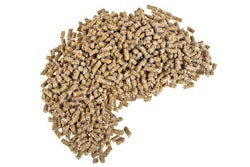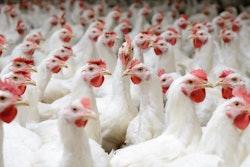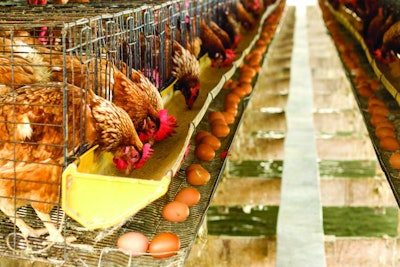
Matching a hen’s nutrient requirements to the time of day can result in production efficiencies
To improve profitability and sustainability, egg producers are considering split feeding. The principle is that hens are fed an a.m. and a p.m. ration, each tailored to the nutrition the birds need at that time of the day for optimum egg production.
Research shows that egg quality will be better, egg size easier to control and longer laying cycles possible.
What is split feeding?
The interest in this technique is re-emerging with flocks kept in production for longer, as the current practice of providing hens with only one diet may not result in optimal utilization of nutrients. Split feeding delivers the optimal supply of nutrients in order to meet the specific needs of the hen during the egg formation process.
Two feeds are supplied at different times of the day:
- The morning diet is designed to meet energy, protein and phosphorus requirements for albumen formation, ovulation and oviposition.
- The afternoon diet is designed to meet requirements for eggshell formation — in particular, higher calcium levels.
Nutritional concept
It has been shown that hens will naturally search out calcium in the afternoon, ready to lay down the shell overnight. Scientists carried out selective feeding trials where hens could choose between rations containing different levels of calcium, energy and protein. They found that hens chose to consume the higher energy and protein diets in the morning and those with higher calcium levels in the afternoon.
The fundamental idea behind split feeding is that hen’s requirements change over the course of the day. In the morning, as soon they’ve laid their egg, hens will start to deposit the egg white around the yolk. Nutritionally, they need available amino acids and energy. It isn’t until late in the afternoon, before the dark period, that they start to form the eggshell. This is why hens are seen pecking more at free access oyster shell in the afternoon. Offering hens different diets in the morning and afternoon offers opportunities for further efficiency by more accurately aligning the supply of nutrients in feed to the requirements of the hen at different times of the day.
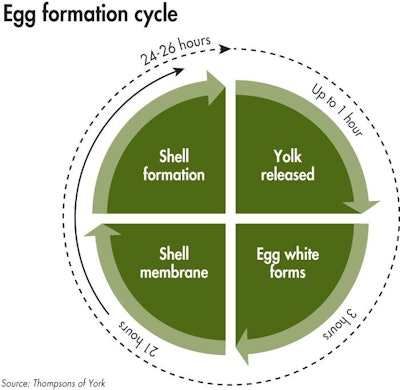
Practicalities of split feeding
From these principles, two rations are formulated: one that is fed in the morning, known as the a.m. ration, and one that is fed in the afternoon, known as the p.m. ration.
The a.m. ration is higher in protein and energy, while the p.m. ration has higher levels of calcium. As the a.m. ration requires less limestone, there is more room for fiber, which also has advantages. A higher-fiber a.m. diet means hens are satiated (feel fuller) in the middle of the day. This is often a time when hens can get bored and may start pecking. The addition of fiber and environmental enrichments has been shown that this is less likely to happen.
The switch to the p.m. diet happens in the afternoon when the focus changes to optimizing calcium intake. In terms of feed allocation, 40% is fed as an a.m. diet and 60% as a p.m. diet, which fits with the natural variation in birds’ feed intake during a day.
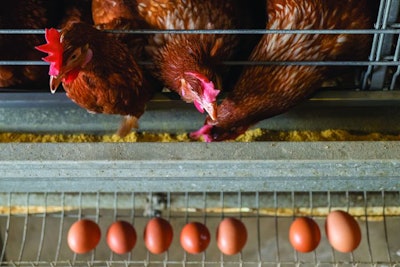 Split feeding programs offer key nutrients at optimal times in the egg formation cycle. (chee gin tan | iStock.com)
Split feeding programs offer key nutrients at optimal times in the egg formation cycle. (chee gin tan | iStock.com)
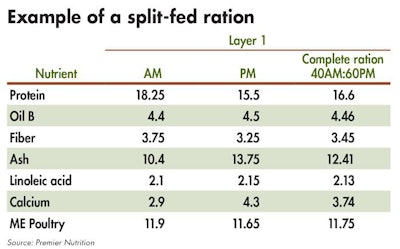
Benefits, efficiencies and environmental impact
The main objective of split feeding is to more accurately meet the bird’s requirements and thereby improve productivity and persistency. In some cases, producers have used it as an opportunity to reduce feed costs, although this is not the primary objective. The laying persistency is of particular interest as producers increase the length of laying cycles. Split feeding supports hens to lay for longer and particularly to produce more saleable eggs late in lay.
The economic benefits of split feeding are as a result of optimizing the use of nutrients according to the bird’s metabolism. This concept gives benefits to the egg producer, including lower cost per ton of feed — and as feed prices rise so the financial benefits increase, lower daily feed intake and improved FCR. It offers effective control of egg size, with fewer cracked and soft-shelled eggs.
Split feeding has also been shown to help free-range egg producers extend laying cycles to 80+ weeks, with an increase in hen housed average at end of flock.
The system inherently wastes less nutrients, as the hens are only given what they need at that time of the day. It has been shown that less nitrogen (10%), phosphorus (5%) and calcium (4.1%) are excreted. This means there are lower levels of potential pollutants, which need to be disposed of and potentially less ammonia produced in the house and muck storage. Another motivator is the increased focus on reducing carbon footprint.
Split feeding reduces soy usage, which is one of the biggest environmental impacts of poultry production.
Split feeding economics
There are relatively few free-range egg producers in the U.K. that are split feeding, but interest in the concept is increasing. As more people adopt the strategy, confidence will grow, encouraging more people to do it. It fits very well with trend for longer laying cycles, helping to ensure an economic number of saleable eggs at the end of the cycle. Shell quality and, in particular, shell strength, is the factor that helps producers make the decision of when to de-populate. If it is improved at the end of the cycle, it means less second-quality eggs and a greater profit.
With high feed costs, there is growing interest from home-mixers, who can save GBP8 to GBP10 (US$11 US$14) per ton of finished feed. Split feeding has the potential to deliver huge economic benefits for egg producer and, while it is relatively common in Spain and Portugal, in the U.K. it is only starting to gain traction.
The drawback for the feed compounder to produce split feeding diets is the number of diets required for a comprehensive feed program. If the feed compounder is producing 10 diets in their conventional range, then a further 20 diets are required to create an a.m. and a p.m. of each conventional diet. This is perceived to be uneconomic for a major feed compounder. However, a regional feed compounder, who already makes bespoke diets, could use this concept to increase their market share.
Splitting the future
Split feeding results in more profitable egg production due to reduced cost of production, improved eggshell quality, increased number of saleable eggs and greater sustainability.
The caveat of this system is that two feed bins are required to deliver the two formulations, along with a feed weighing system and an automated system to change the ration over twice a day. Investment is required for existing housing systems and design considerations for those newly built, but with ever-improving equipment and IT solutions, confidence in split feeding is growing.
Many people believe split feeding will become commonplace on laying hen farms, as producers strive for sustainability and efficiency.

